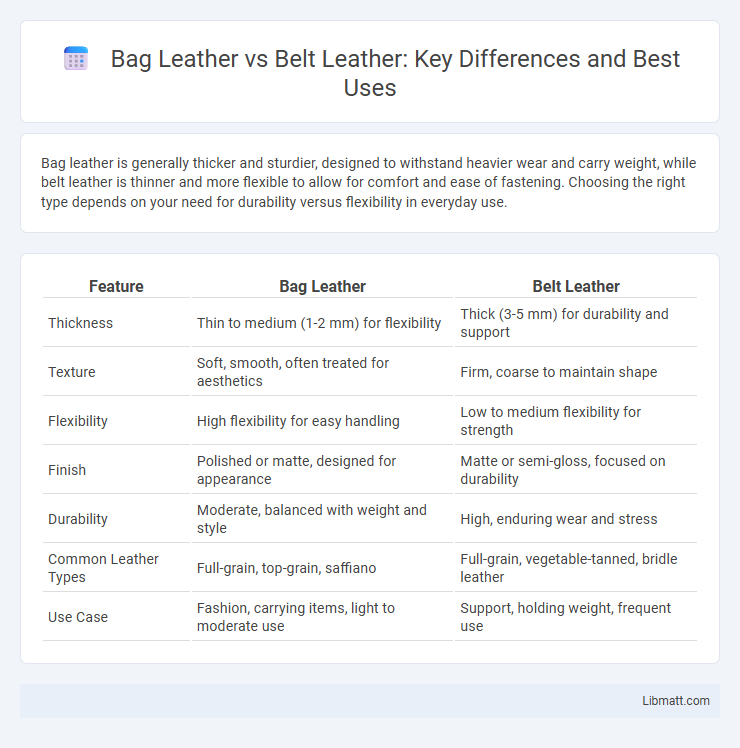Bag leather is generally thicker and sturdier, designed to withstand heavier wear and carry weight, while belt leather is thinner and more flexible to allow for comfort and ease of fastening. Choosing the right type depends on your need for durability versus flexibility in everyday use.
Table of Comparison
| Feature | Bag Leather | Belt Leather |
|---|---|---|
| Thickness | Thin to medium (1-2 mm) for flexibility | Thick (3-5 mm) for durability and support |
| Texture | Soft, smooth, often treated for aesthetics | Firm, coarse to maintain shape |
| Flexibility | High flexibility for easy handling | Low to medium flexibility for strength |
| Finish | Polished or matte, designed for appearance | Matte or semi-gloss, focused on durability |
| Durability | Moderate, balanced with weight and style | High, enduring wear and stress |
| Common Leather Types | Full-grain, top-grain, saffiano | Full-grain, vegetable-tanned, bridle leather |
| Use Case | Fashion, carrying items, light to moderate use | Support, holding weight, frequent use |
Understanding the Differences: Bag Leather vs Belt Leather
Bag leather is typically softer, more flexible, and designed for durability and aesthetic appeal, making it ideal for carrying comfort and style. Belt leather is thicker, stiffer, and treated to withstand constant tension and wear, ensuring long-lasting strength and shape retention. Understanding these differences helps you choose the right type of leather for your specific needs, whether it's for a stylish accessory or a functional, durable belt.
Common Types of Leather Used for Bags and Belts
Full-grain leather is a popular choice for both bags and belts due to its durability and natural texture that improves with age. Top-grain leather offers a smoother finish and is often used in belts, while split leather, including suede, is more common in bags for its softness and flexibility. Your selection depends on the desired strength and appearance, with bag leather typically emphasizing lightweight and supple qualities, and belt leather prioritizing rigidity and sturdiness.
Durability Comparison: Bag Leather vs Belt Leather
Bag leather is designed to withstand frequent handling, exposure to elements, and bending, offering high durability with flexibility and resistance to wear. Belt leather, typically thicker and more rigid, provides exceptional tensile strength and abrasion resistance to endure constant pulling and friction against belt loops. While bag leather balances softness and toughness for everyday use, belt leather prioritizes structural integrity and longevity under continuous strain.
Thickness and Flexibility: How Bag and Belt Leathers Differ
Bag leather typically features greater thickness, ranging from 2.0 to 4.0 mm, providing durability and structure required for carrying heavier items. Belt leather is generally thinner, between 3.0 to 4.5 mm, and possesses higher flexibility to ensure comfort and ease of movement around the waist. Your choice depends on whether you prioritize the rigidity and robustness of bag leather or the pliability and wearability inherent in belt leather.
Tanning Processes for Bag Leather and Belt Leather
Tanning processes for bag leather typically involve vegetable tanning, which uses natural tannins from bark and leaves to create a supple, durable texture ideal for flexibility and aesthetic appeal in bags. Belt leather often undergoes chrome tanning, a faster chemical process that produces stiffer, water-resistant leather, ensuring strength and longevity for everyday wear. Understanding these tanning differences helps you choose the best leather type for your specific accessories.
Surface Finish: Smoothness and Grain in Bag vs Belt Leather
Bag leather typically features a smooth, refined surface finish with a finer grain to enhance its aesthetic appeal and softness, making it suitable for luxury and fashion items. Belt leather generally presents a more rugged, coarser grain with a matte or slightly polished surface, ensuring durability and resistance to wear from frequent flexing. Your choice depends on the desired balance between visual elegance and practical toughness.
Hardware Compatibility: Leather Choices for Bags and Belts
Bag leather typically requires hardware like D-rings, swivel clasps, and buckles designed to withstand frequent movement and weight distribution, while belt leather hardware focuses on robust, sturdy buckles that endure consistent tension and flexing. Thicker, more rigid belt leather pairs well with heavy-duty metal hardware such as roller buckles, whereas softer, more pliable bag leather complements lightweight closures and decorative metal accents. Selecting the appropriate hardware ensures durability, functionality, and aesthetic harmony tailored to the leather type and intended use.
Color Options: Dyeing Techniques for Bags and Belts
Bag leather offers a wider range of color options due to advanced dyeing techniques such as aniline, semi-aniline, and pigmented finishes, allowing for vibrant or natural hues. Belt leather typically undergoes more uniform dyeing processes, like drum dyeing or immersion dyeing, to ensure consistent saturation and durability under frequent wear. Your choice between bag leather and belt leather should consider how these dyeing methods impact both color richness and long-term colorfastness for your accessory.
Maintenance and Care: Bag Leather vs Belt Leather
Bag leather typically requires regular conditioning with specialized leather creams to maintain suppleness and prevent drying, while belt leather often demands less frequent care but benefits from occasional polishing to retain its finish. Both types of leather should be cleaned gently with a damp cloth and kept away from excessive moisture and direct sunlight to avoid cracking and discoloration. Proper storage, such as hanging belts and storing bags in dust bags, helps preserve shape and extends the lifespan of the leather.
Choosing the Right Leather: Suitability for Bags or Belts
Bag leather typically features a softer, more flexible texture designed to withstand daily handling and maintain its appearance despite frequent use. Belt leather requires higher durability and stiffness to provide reliable support and retain shape over time, often crafted from thicker hides with a firmer finish. Your choice should reflect the intended use, prioritizing supple, lightweight leather for bags and robust, resilient leather for belts.
Bag leather vs belt leather Infographic

 libmatt.com
libmatt.com